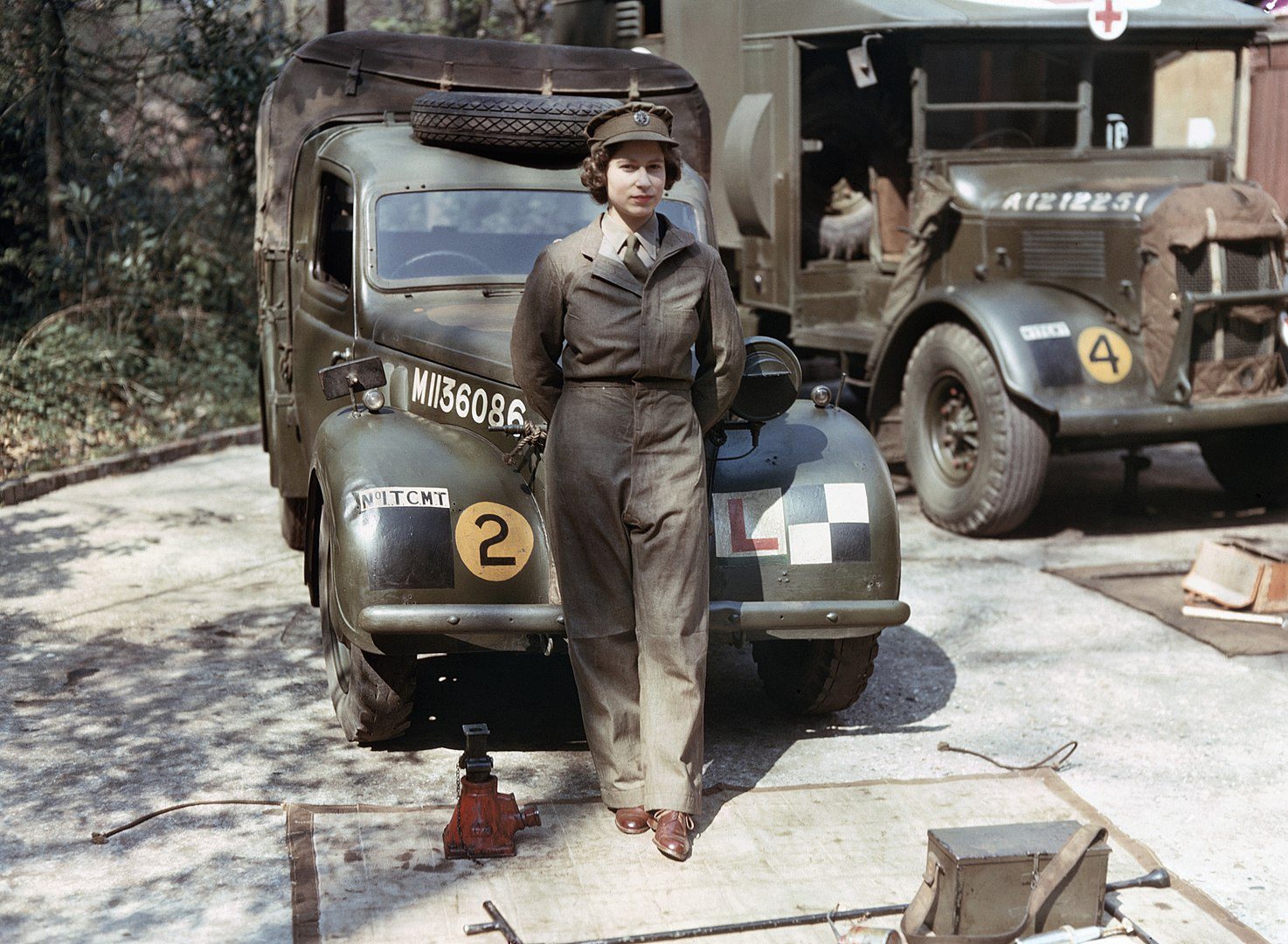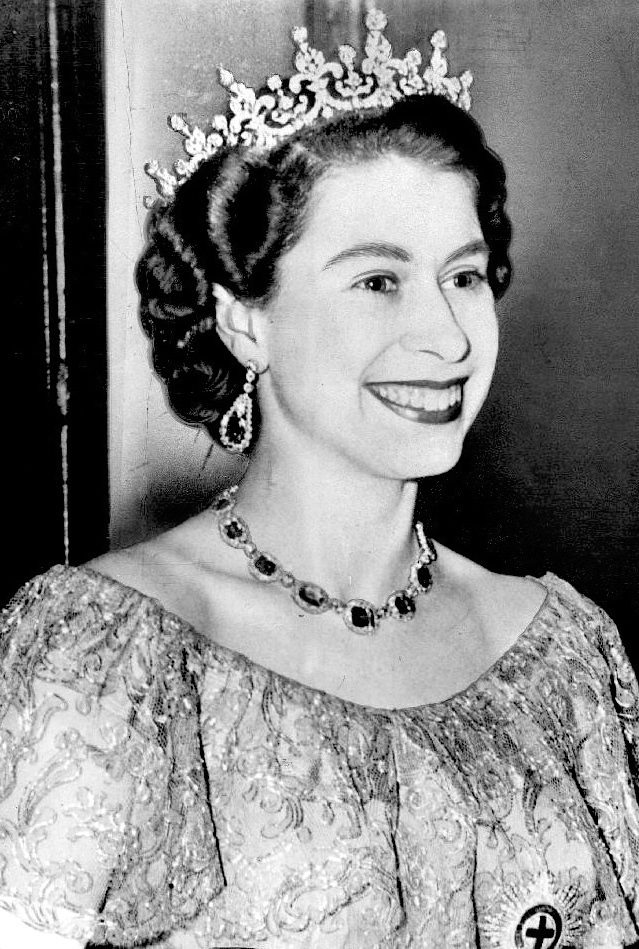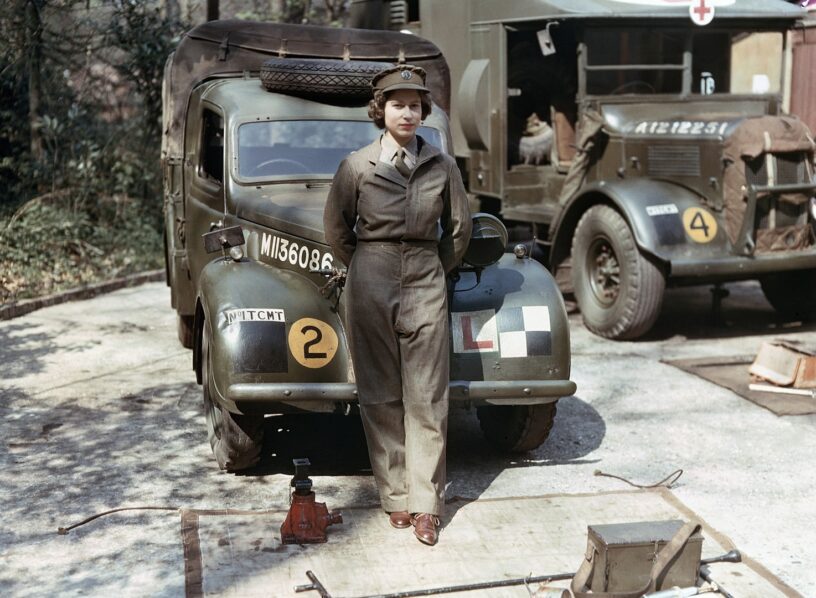
Queen Elizabeth II (Berlin 2015). Photo by
PolizeiBerlin. Wikimedia Commons.
Queen Elizabeth II during World War II: 10 Things you should know
Queen Elizabeth II goes down in history as the longest-reigning British monarch (70 years), and she will also be fondly remembered for having served in the British military during World War II. Her incredible display of strength, discipline, and courage in her formative teenage years and particularly during the war served to build upon her reign later on. Princess Elizabeth, as she then was, was only 13 years old when the war broke out in 1939. Her mother, Queen Elizabeth (known as Queen Mother), and her father, King George VI were at the frontlines in showcasing resilience for Britain during World War II. Queen Elizabeth II followed suit, and here are the 10 things you should know about her role during the war.
1. Her family refused to leave London despite the dangers of a raid

H.M. Queen Elizabeth, accompanied by Matron Agnes C. Neill, talking with personnel of No.15 Canadian General Hospital, Royal Canadian Army Medical Corps (R.C.A.M.C.), Bramshott, England, 17 March 1941. Photo by Canada. Dept. of National Defence. Wikimedia Commons.
Just like everybody else caught up in the crossfire, the Royal Family was not exempted. Despite being advised to leave London or at least send their children, then Princess Elizabeth and Margaret to Canada, Queen Elizabeth the Queen Mother famously stated, ‘The children will not go without me, I will not leave the King, and the King will not leave London under any circumstances.’ Their refusal to flee from the looming danger and choosing to stay in solidarity with the rest of the nation was significantly symbolic. It also strengthened the morale of the British citizens.
2. Buckingham Palace was bombed in 1940 during the Blitz
Barely weeks after Germany’s resolve and campaign to bomb cities in Britain began, five bombs were dropped on Buckingham Palace on September 13, 1940. Several parts of the building were damaged, including the inner quadrangle, Royal Chapel, and the Palace Gates. Some workmen were also injured, but the Royal Family survived unscathed. The Queen Mother is reported to have said, ‘I’m glad we have been bombed. Now we can look in the East End in the Eye.’ The Royal family still chose to stay in London.
Check out the Top 10 Facts about Buckingham Palace.
3. Her father, King George VI played an important role in boosting British morale

HM King George VI (center)With the British Liberation Army in Holland, 13 October 1944. Photo by Malindine E G (Capt). Wikimedia Commons.
King George VI gave speeches, encouraging the resolve of the British people to remain resilient and hopeful throughout the war. Alongside his wife, Queen Elizabeth, they visited most parts of London that had been hit during the air raids and comforted residents and workers in the local emergency services. The presence of the Royal family in leading Britain through one of the darkest times in history was indeed felt. Queen Elizabeth also visited troops in hospitals.
4. Elizabeth and her sister were sent to live in Windsor Castle for safety
Many children were evacuated from the cities to small towns or the countryside to keep them safe from air raids. The Children’s Overseas Reception Board also evacuated over 2,600 children to Canada, New Zealand, South Africa, and Australia. Although Princess Elizabeth and her sister Princess Margaret did not leave the country, they were moved a few miles outside London, to Windsor Castle, where they stayed for the better part of the war.
5. She made her first public broadcast in 1942 at age 14
Many children were being forced to leave London for safety, being separated from their parents during the war. Queen Elizabeth, only a 14-year-old princess at the time made a broadcast encouraging the children, and offering a message of comfort and hope. It was on October 13, 1940, when she gave her first address from the drawing room of Windsor Castle as part of the BBC’s Children’s Hour program. Speaking directly to the children, she said in part, ‘My sister Margaret and I feel so much for you, as we know from experience what it means to be away from those you love most of all. To you living in new surroundings, we send a message of true sympathy and at the same time we would like to thank the kind people who have welcomed you to their homes in the country.’
Without a doubt, World War II had far-reaching effects on mankind, and here’s more on 20 Historical Events that Radically Changed the World.
6. She became an honorary colonel of the Grenadier Guards in 1942

Allied Preparations For D-day Princess Elizabeth inspecting an honour guard during a Royal visit to 2nd (Armoured) Battalion Grenadier Guards, 5th Guards Armoured Brigade, Guards Armoured Division, at Hove, 17 May 1944. Photo by War Office official photographer, Malindine E G (Captain). Wikimedia Commons.
Barely a year after gaining this title, and on the morning of her sixteenth birthday, she inspected for her first time, a military regiment during a parade at Windsor Castle. The title of honorary colonel symbolized her military involvement in the war effort. She also took part in the ‘Dig for Victory Campaign’ at 14 while staying at Windsor Castle. British people had been encouraged to dig up their gardens and grow food in the face of increasing food rationing amidst the war.
7. She joined the Auxiliary Territorial Service at 18

Princess Elizabeth, a 2nd Subaltern in the ATS. Photo by Ministry of Information official photographer. Wikimedia Commons.
This had been established by King George VI, enabling women to participate in the war effort. Her mother had been instrumental in its formation. Jobs such as clerks, postal workers, ammunition inspectors, cooks, searchlight operators, and drivers were available for women, which helped free up the men to fight on the front. Some women were allowed to serve in the anti-craft units except for firing guns. Unmarried women under 30 years were allowed to sign up. Upon turning 18 in 1944, Princess Elizabeth expressed her interest in joining the ATS. Her father, King George IV ensured that she did not receive any special rank or treatment. She started as a second subaltern before being later promoted to Junior Commander.
Women have indeed played key roles in war. Have a look at Women of World War I: All you need to know about their role in the war.
8. She was nicknamed ‘Princess Auto Mechanic’

Auxiliary Territorial Service: Princess Elizabeth, a 2nd Subaltern in the ATS, wearing overalls and standing in front of an L-plated truck. Photo from collections of the Imperial War Museum. Wikimedia Commons.
Having decided to join the ATS as a mechanic and driver, she began her training as a mechanic in March 1945. She attended her vehicle maintenance and driving course at Aldershot, where she qualified on April 14. Although she spent a greater part of the day at the training site, she returned to Windsor Castle in the evening to sleep since it was relatively close, rather than sleep with her fellow ATS colleagues. At the time, the media had nicknamed her ‘Princess Auto Mechanic.’
9. She saved her clothing ration coupons to pay for her wedding dress

Queen Elizabeth II (1953). Photo by Associated Press – eBay. Wikimedia Commons.
Even after the war, Britain was still grappling with shortages in food and labor, and austerity measures were being undertaken by all to curb this. Elizabeth, leading by example in post-war Britain, saved her ration coupons for her wedding dress in 1947 when she got married to Prince Phillip. Some of the members of the public, sent their clothing coupons to help her pay the cost but since it was prohibited to transfer ownership of coupons, each coupon was sent back to its owner with a thank you note.
Read more on Top 10 Remarkable Facts about Queen Elizabeth II of England.
10. She was the first female Royal member on active duty during wartime

Queen Elizabeth II (Berlin 2015). Photo by
PolizeiBerlin. Wikimedia Commons.
Being a member of the Auxiliary Territorial Service, Princess Elizabeth, as she then was, was the first female of the Royal Family to be an active duty member of the British Armed Forces. Until her death on 8 September 2022, she was the last surviving head of state to have served during World War II. Often, she was known to repair faulty engines, just like she had been trained to do during her time in the ATS.
Have a look at the 25 Things you need to Know about Queen Elizabeth II Coronation.
Planning a trip to Paris ? Get ready !
These are Amazon’s best-selling travel products that you may need for coming to Paris.
Bookstore
- The best travel book : Rick Steves – Paris 2023 – Learn more here
- Fodor’s Paris 2024 – Learn more here
Travel Gear
- Venture Pal Lightweight Backpack – Learn more here
- Samsonite Winfield 2 28″ Luggage – Learn more here
- Swig Savvy’s Stainless Steel Insulated Water Bottle – Learn more here
Check Amazon’s best-seller list for the most popular travel accessories. We sometimes read this list just to find out what new travel products people are buying.










